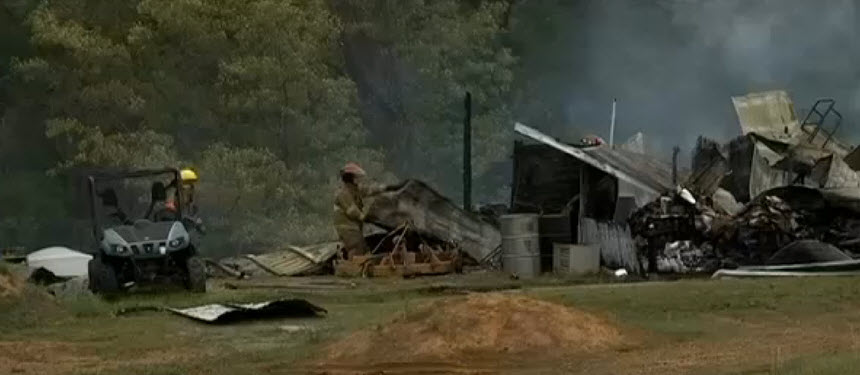
On April 24, an explosion and subsequent fire occurred at Silver Trail Distillery in Hardin, Kentucky. Second Distiller Jay Rogers and Assistant Distiller Kyle Rogers were in the distillery at the time. Both men received severe burns from the incident and were flown to Vanderbilt University Medical Center. Sadly, Kyle Rogers succumbed to his injuries and passed away on May 11, 2015. Kyle is now back home and continues his journey to recovery.
Stay Informed: Sign up here for our Distillery Trail free email newsletter and be the first to get all the latest news, trends, job listings and events in your inbox.
The report from Bill Compton, SFMO Primary Investigator says the still was fueled by propane but there was no evidence of a propane release. Typical of a propane explosion is significant damage of the structure as well as a distinct debris field as a result of the blast. Spencer Balentine, owner of Silver Trail Distillery and Jay Rogers both confirm that the structure was still standing after the initial event. Jay Rogers stated that the only things that he could tell that were displaced after the event were the metal sliding door on the north end of the building and the still itself. First responders on the scene found the metal structure to still be intact and standing when they first arrived. Jay Rogers also confirmed there was no fireball with the event and no propane odor prior to the event.
The bottom of the still was blown away from the sidewall of the pot which is consistent with pressure build up inside the vessel. All indications are that the event directly involved the over pressurization of the still with subsequent failure which resulted in it being propelled out the north end of the building.
When Compton arrived on the scene he said, “I observed what appeared to be the smoldering remains of a metal sided pole barn that had been consumed by fire. I saw no visible debris field that would typically result from an explosion. Metal tin was lying outside of the building perimeter but it appeared to be as a result of firefighters dragging it out of the scene during the overhaul operations, which were still in progress.
As I walked pass the fire scene to the residence (Balentine’s home is on the property) I saw what appeared to be the remains of the alcohol still lying in the gravel driveway on the north end of the building.
I asked Mr. Ballentine for a brief overview of the situation. Mr. Balentine advised that he was at his residence finishing up breakfast when he heard a pop. His wife was ironing at the time and said she thought something had happened up at the distillery. Upon looking out his window he noticed the large metal door on the north end of the building was pushed out. He ran up to the distillery from his residence to find his two employees that were working in the distillery at the time to be outside and severely injured. He shut off the propane at the tank and inquired what happened with Jay Rogers, his second distiller. Jay Rogers advised that the still blew. Mr. Balentine went inside the distillery and saw what he thought was flaming mash on the walls. He helped his employees down to his residence and had his wife call 911. Mr. Balentine advised that there was nothing out of the ordinary that had occurred prior to the event. Upon asking if there had been any issues with the still, he advised that on the second run of the still after purchase the seam that secured the bottom to the sidewall split. The split was approximately 3 inches wide and allowed the liquid in the pot to squirt out of the split in a flat stream looking similar to the end of a paint brush. He further explained that he reached out to the manufacturer of the still. Revenoor Stills, and got advice on how to repair the split. There had been no further mechanical issues with the still. (Note: The split occurred approximately 3 years prior to the event.)
There were no physical signs inside the remains of the structure of any explosion or blast wave. The only obvious physical indications of anything being displaced as a result of an incident at the facility was the copper still that was now resting in the driveway on the north end of the remains of the structure. The body of the copper still (aka the “pot”) was located approximately 50′ from the north end of the structure in the gravel driveway lying on its side. The copper column of the still, which would have been bolted to the top of the pot, was located in proximity to the pot and approximately 72′ from the end of the structure. Also located 95′ from the north end of the building in the gravel driveway was a round stainless steel plate. The plate appeared to be utilized as an access opening in the top of the pot of the copper still. Closer examination of the pot revealed the side wall of the pot to be intact. However, the bottom of the still was folded back away from the side walls and only remained attached at one narrow point.
The fire marshal goes on to interview Mr. Balentine. During the interview Mr. Balentine stated the still in question was a 300 gallon unit produced by Revenoor Stills of Yamhilt, Oregon. The still was ordered with electric heating elements but they were never wired up. Mr. Balentine advised that he utilized propane to fire the still because he found that he had better luck. He had a base constructed for the still to sit on which housed the 4 burners for the still. Installed in the base was a ventilation fan that pushed combustion of gas to the exterior of the building by way of vent pipes. Upon asking Mr. Balentine how he regulated the temperature of the pot, he explained that he did so by cutting back on the propane burners. He also advised that the column temperature was regulated by water flow into the coils inside the column. Both the column and the pot of the still would be operated around 200°-204° and the column around 190°. Mr. Balentine confirmed there were no pressure gauges installed anywhere in the still.
During the investigation, Mr. Balentine gave an overview of the circumstances leading up to the event. He explained that “he was first under the impression that the event knocked his employees out of the building. Since the day of the explosion he had communicated with Second Distiller Jay Rogers, who was still in the hospital, and found out that Jay and Kyle Rogers were not blown out of the building. Jay Rogers had assisted Kyle Rogers out of the building after the event had occurred. Additional information from Mr. Balentine revealed that whistling had previously been heard coming from around the stainless steel access plate in the top of the still.”
During the investigation the temperature and pressure valve were removed to be examined. Visual examination revealed no obvious issue and the valve reflected no signs of debris that would have occluded the valve.
The fire marshal goes on to say, “There are several possible reasons or combination of reasons for the failure. One hypothesis is that the still, which is normally an open system, became restricted allowing the buildup of pressure causing its ultimate failure. This could happen due to the output of the still where the finished product is discharged becoming plugged. Based on Jay Rogers statement there was not an issue with the output of the still as several gallons of finished product had already been produced with production ongoing at the time of the event. Over pressurization could occur if the column somehow became obstructed. As previously noted the column contained significant amount of glass balls inside of the column. My understanding of the use of glass balls “packing” is to allow for a large surface area to allow condensation to attach to during the distillation process. Unfortunately, placing objects inside the column can reduce flow which could ultimately result in unintentionally over pressurization of the still. Witness statements regarding hearing a rattling or chatter noise from the column on the still may have been indication of pressure build up in the still.
The Revenoor Still which failed was equipped with a temperature and pressure relief valve manufactured by Watts. The valve, Model LLL100XL, is rated for 150°psi and 210°F. The valve was installed in the top of the still in the vapor space. Being that the still was not designed or intended to be a pressure vessel, a pressure relief valve rated at 150°psi appears very excessive. On the information sheet under “Safety and Maintenance” it states that “Each Revenoor still is built with a safety valve and operated on less than one pound of pressure.” This is in direct contradiction to the rating listed on the valve installed. If the restriction did occur in the column or in the output it may be possible that the still failed before adequate pressure could be generated to operate the valve.
It should also be noted that the Watts Model LLL100XL, valve is only listed for use in water heaters and in this application has been utilized outside of its listing.
The fire marshal also contacted and subsequently interviewed Terry Wilhelm of Revenoor Stills of Yamhill, Oregon. The report says, “Mr. Wilhelm stated that the still that Revenoor produced, if everything is working correctly, are not a pressure vessel and that they are open to the atmosphere. He further explained that after production the pot and the column are tested at 3 psi to check the integrity of the welds. He went on to say that at about 4-5 psi you will start to get cracks in the welds and that even if the pressure does build up that the pot does not explode. He stated that the pot would typically bulge apart until a crack developed in the silver solder welds. Mr. Wilhelm relayed that the welds that seamed the components together were “tig” welds using Harris “0” Silver Solder. I inquired with Mr. Wilhelm as to why he utilized a temperature and pressure relief valve in the still if it was not a pressure vessel.
He answered that it was primarily to keep the lawyers away and to act as a backup just in case the output on the still becomes blocked.
Mr. Wilhelm further stated that 9 out of 10 times you would see a crack in a weld before the temperature and pressure relief valve activated. He further stated that steam build up could cause the temperature and pressure relief valve to operate.” At the conclusion of the interview, Mr. Wilhelm assures the Fire Marshal that he will continue to cooperate in the investigation.
The Fire Marshal concludes that based upon the available information and evidence; there is no indication that the event at Silver Trail Distillery was anything other than an accident.
A complete copy of the fire marshals final report can be read here.








